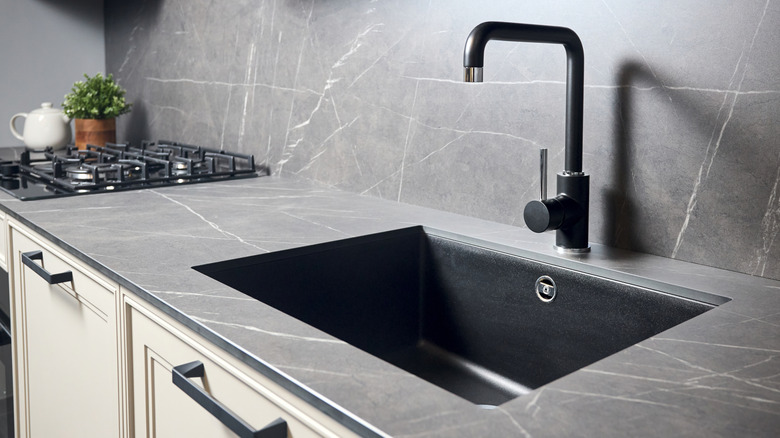What Causes Undermount Kitchen Sinks To Drop Over Time And How To Prevent It
If you're looking for a streamlined, integrated sink, look no further than an undermount. Because it's installed below the counter, you don't see the rim of the sink at all, so whether it's made of fireclay to fit in with these country-style kitchen trends, or granite for a sleek, modern vibe, an undermount sink will give your countertop a smooth, continuous look and make cleaning easier too: Just wipe crumbs into the sink without any hassle! But it's not all sunshine and rainbows; these sinks can drop over time if not properly installed. To find out why this happens, and how to prevent it, Food Republic spoke with Jonathan Palley, CEO of Clever Tiny Homes.
"Undermount sinks are fighting against gravity," Palley explained. "The weight of the sink and drain pipes, as well as the water itself, will pull down on any fasteners or adhesives and eventually cause the sink to detach." Aside from the sink itself, you'll also need to consider what will be going in said sink, as heavy pots and pans can quickly add on weight. To prevent collapse, use a high-quality adhesive or fixing material to seal the sink to the countertop. To provide a watertight bond and guaranteed structural support, use an extremely strong adhesive like two-part epoxy adhesive, and to protect yourself from any potential leaks, seal the edges with a high-grade silicone sealant. For peace of mind, we recommend hiring a professional with experience in installing this kind of sink, rather than doing it yourself — no matter how much faith you have in your DIY skills!
Other tips to prevent your undermount sink from dropping
One of the best parts about designing your kitchen is playing around with different materials — like deciding whether quartz or granite is better suited for your countertop, for example. But when installing an undermount sink, the countertop material you choose might be the difference between long-term durability and imminent collapse. The best countertop materials to go for are durable, solid, and designed to last — like stain-resistant soapstone. Ideally, it should have enough strength to support the sink whether it's full or empty.
Although the seamless integration of the undermount sink is one of its main selling points, a con of this is that the countertop will be constantly exposed to water, so you'll want to avoid water-absorbing porous countertop materials as "you've got the risk of water damage eroding the connection point," Jonathan Palley explained. For this reason, Palley recommended avoiding choices like laminated particleboard, marble, or limestone. If you happen to already have a countertop made of one of these materials, consider applying a sealant to create a protective barrier against liquid or other substances seeping into its pores.
Another effective trick to prevent your undermount sink from dropping is to provide it with structural reinforcement. "The gold standard, if you have the space for it, is adding supports directly under the sink," Palley explained. "This will help to take most of the weight and keep the adhesive intact." For additional support without taking up too much cabinet space, consider purchasing brackets, which can be installed both vertically and horizontally.


